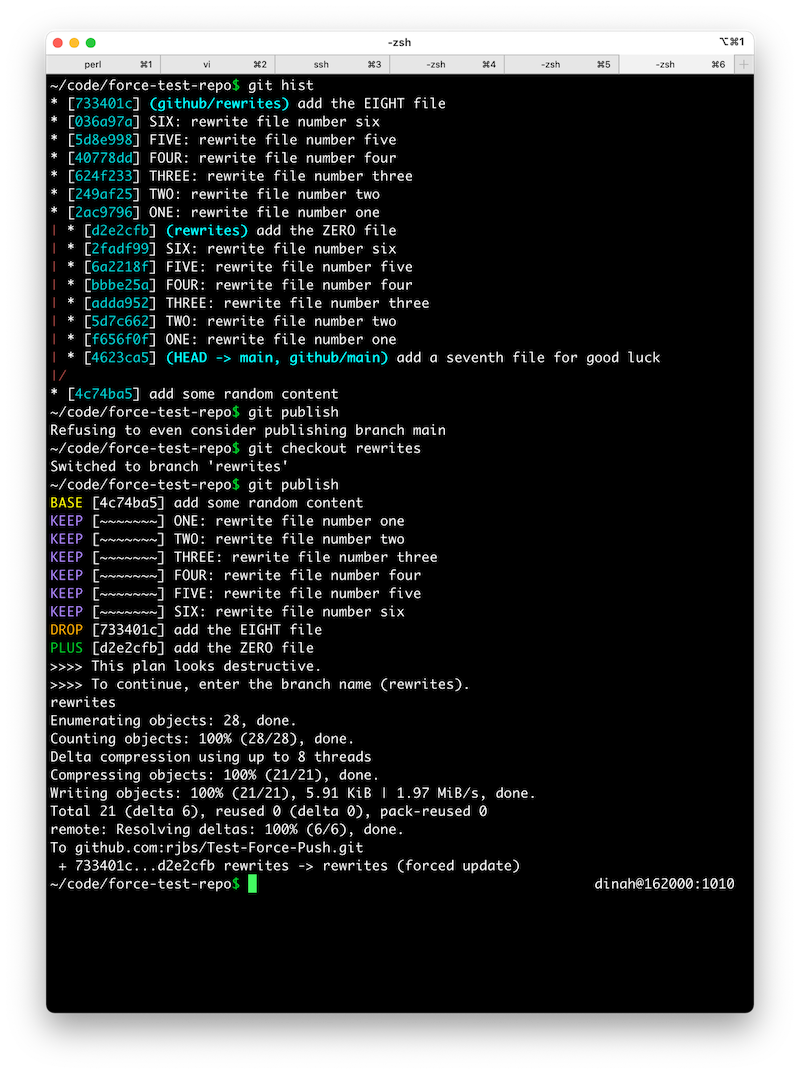adding some safety to git force-push
Just the other day, I wrote about my little git branch manager tool. I use it to make sure I know what branches I have lying around, and to delete branches that have already been merged. I wrote the post because I had updated the code to work on more kinds of respository.
I updated the code to more on more kinds of respository because I wanted to write a different program to do something similar. See, about a week ago, I did a force-push that I shouldn’t have. The history looked something like this:
* [733401c] (github/rewrites) add the EIGHT file
* [036a97a] SIX: rewrite file number six
* [5d8e998] FIVE: rewrite file number five
* [40778dd] FOUR: rewrite file number four
* [624f233] THREE: rewrite file number three
* [249af25] TWO: rewrite file number two
* [2ac9796] ONE: rewrite file number one
| * [d2e2cfb] (HEAD -> rewrites) add the ZERO file
| * [2fadf99] SIX: rewrite file number six
| * [6a2218f] FIVE: rewrite file number five
| * [bbbe25a] FOUR: rewrite file number four
| * [adda952] THREE: rewrite file number three
| * [5d7c662] TWO: rewrite file number two
| * [f656f0f] ONE: rewrite file number one
| * [4623ca5] (github/main, main) add a seventh file for good luck
|/
* [4c74ba5] add some random content
What you’ll see here is that there’s a common base, then two versions of the
same branch. One version (the local one) has been rebased on main. The
other one is up on GitHub. Both of them have had new commits added. If you
did a force-push of the rewrites branch, you’d clobber the “EIGHT” commit.
To avoid screwing up a force push, the advice includes “use
--force-with-lease” which is good advice, it means “don’t replace the remote
if it’s different than my fetch of it.” That protects you against having it
changed out from under you. It still means you have to read and compare the
version you see with the version you want to push.
What I wanted was to avoid having to think about that whenever possible, and I knew there was a way to do it.
I wrote a new program, git-publish, that tries to turn the problem into this one:
- While working on the
foobranch, I rungit publish - If there is no foo branch on my remote, my local branch is published to my remote.
- If there is a remote branch foo, and my changes are a fast forward, they’re pushed up.
- If there’s a remote branch foo, and my copy has rebased it and then (maybe) added commits to the end, a force-with-lease push is made.
Already, this is a pretty good win, covering some of the “is it safe?” questions in code so that I don’t need to. The last case is “the difference is more than a rebase”, and what I wanted was a means to see that explained. So, the last option is:
- If the remote branch exists and my local branch doesn’t just rebase-and/or-add, then an explanation of the changes (and non-changes) is printed, showing me what I’d really be doing if I force-pushed. I can instruct the program to continue (and it will force-with-lease push) or I can abort and sort things out by hand.
I’ll probably refine this last step a bit more. I think I can at least add a
step that’s “cherry pick commits from the remote that aren’t on this branch”,
and I’d put them after the common commits but before the new commits on my
local branch. Even without that, though, this is a pretty nice little tool. I
hope to use it more than git push from now on.
